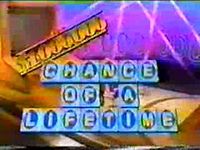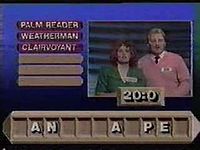- The $1,000,000 Chance of a Lifetime
-
For the unrelated Australian game show, see The $1,000,000 Chance of a Lifetime (Australian game show).
The $1,000,000 Chance of a Lifetime 
Format Game show Presented by Jim Lange Narrated by Marc Summers (1986)
Johnny Gilbert (1986–1987)Country of origin  United States
United StatesNo. of seasons 2 Production Location(s) Hollywood Center Studios
Hollywood, CaliforniaRunning time approx. 22–26 Production company(s) XPTLA Company Distributor Lorimar-Telepictures Broadcast Original channel Syndicated (daily) Original run January 6, 1986 – September 11, 1987 Chronology Related shows All Clued Up (UK version) The $1,000,000 Chance of a Lifetime is an American game show which offered a $1 million (annuitized) grand prize to winning contestants. Based on a late 1970s unsold game show pilot titled The Letter Machine, the show aired in syndication from January 6, 1986 until September 11, 1987. The show was hosted by Jim Lange, and he was joined by Karen Thomas as co-host during the second season. Marc Summers was the show's announcer for its first few weeks and Johnny Gilbert announced the remainder of the series. The show was produced by XPTLA, Inc. and distributed by Lorimar-Telepictures.
Contents
Gameplay
Two couples competed each day, one of which was usually a returning champion. The two couples tried to win money by solving Wheel of Fortune-style word puzzles.
In order to fill in the blank spaces in the puzzle, a series of toss-up clues was played; these were usually one-word clues but certain clues called for two or even three words to be used. The letters would be filled in one at a time until all but the last letter had been revealed or until one of the players buzzed in with a correct answer. Doing so won money and the right to choose two letters from a gigantic computer keyboard. If a player gave an incorrect guess, the opposing player got to see all of the remaining letters and was given a chance to guess.
In addition to letters, a star appeared on the keyboard to indicate whether there were punctuation marks or numbers in the puzzle. After the first toss-up clue was played, all of the letters that were in the puzzle would be lit up on the keyboard as well as the star if there were any numbers or punctuation marks in play. The toss-up winner chose two of the letters. For each time one of those letters appeared in the puzzle, money corresponding with the amount of the toss-up clue was added to a pot. One additional letter that was not in the puzzle was also lit. Referred to as "The Stinger", picking this letter resulted a loss of control and a new toss-up word was played. Otherwise, the player in control was given a chance to solve the puzzle. Play continued until the puzzle was solved, and the couple that did so won the pot.
In the first round, toss-up clues and revealed letters were worth $25. This doubled to $50 for the second round and doubled again to $100 for the third and subsequent rounds, time permitting. If time ran short while a puzzle was being played, each of the remaining letters would be placed one at a time until one of the players buzzed in with a correct answer (the value of each revealed letter would continue to be added to the pot until that happened). Whichever couple was in the lead after the final puzzle won the game and whatever cash they had earned while the other couple left with a copy of the show's home game, various parting gifts, and whatever previous front-game winnings they had earned if they were a defeated champion.
If there was a tie after the final puzzle, a final toss-up clue was played. If the first player to buzz in answered correctly, the couple won the game. An incorrect answer resulted in an automatic loss and the opposing couple played the bonus round.
Bonus round
After choosing one of three possible categories, the couple entered an isolation booth wired so they could only hear Lange. The couple had 60 seconds to guess words or phrases pertaining to that category. For each word, a letter was randomly filled in once every 1.5 seconds. Once the couple guessed correctly, the next word/phrase was immediately put into play and the clock did not stop until they gave six correct answers or the 60 seconds ran out.
If the couple successfully completed the bonus round in their first attempt, they were offered a $5,000 and a choice to retire as undefeated champions or to return the next day and face another couple on the following show. If the couple chose to return and then completed the bonus round a second time, the offer increased to $10,000. In addition, if a winning couple failed to complete a bonus round on either the first or second attempt, they were immediately retired with only their main game winnings.
If the couple advanced to the bonus round for a third day, they played for the $1,000,000 top prize. For the first half-season, the top prize was an annuity paid in annual installments of $40,000 for 25 years. For the second season, the top prize consisted of two cars, ten pairs of round-trip Delta Air Lines tickets to anywhere in the continental United States, an outdoor spa, a new kitchen, living room, and dining room, and a $900,000 annuity paid in annual installments of $36,000 for 25 years.
United Kingdom version
All Clued Up aired on ITV from August 16, 1988 to August 30, 1991. It was produced by TVS and hosted by David Hamilton.
References
External links
Categories:- American game shows
- First-run syndicated television programs in the United States
- 1980s American television series
- 1986 television series debuts
- 1987 television series endings
- Television series by Warner Bros. Television
- English-language television series
Wikimedia Foundation. 2010.

